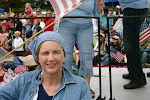Book Review: Darkness at Sunset and Vine
Darkness at Sunset and Vine: Trilogy by Ginger Mayerson (2012 Wapshott Press)
For real-life darkness around the world-famous intersection of Sunset and Vine, how about the gay hairdresser who wanted to blow up a whole block of Los Angeles to get revenge on his ex? As Mike Rothmiller and Ivan G. Goldman relate in their expose LA Secret Police, the guy wanted to hire a hit man to blow up his ex inside the beauty shop they owned together. He thought if he blew up the whole block, that'd throw police off the scent.
If you can appreciate such factual logic, perhaps you can appreciate Ginger Mayerson's fictional Darkness at Sunset and Vine: Trilogy, written as a satire of the Bush II administration in 2003, produced in part as a play in 2008, and published by Wapshott Press as a three-part novel in 2012.
Seeing as how it's set in then-future 2016 Los Angeles, how does it play in the Trump era? The title is a reference to the anti-Stalinist classic Darkness at Noon, but America under either Bush (that's either Bush) or Trump isn't Stalin's Russia, where Communism spawned a totalitarian state. We're not there--yet--so Mayerson's premise sets up a false analogy. Actually America under Trump may have suffered a worse fate than the cartoon-villain world the author subjects her readers to, where every conflict is solved by killing, the more people and the more horrifically, the better. If only ending the Republican right's grip on our nation were that simple.
Mayerson's other works show she's a far more credible writer than the simple-minded violent bloodbaths she strings together here. She credits three editors, but this book reads like lazy schoolwork, lacking even rudimentary plot or character development. Think back to elementary school, when the teacher assigned students to write stories from an ant's point of view, with the results often being variations on, "Army ants attacked my garden, so I took my pincers and cut off all their heads." That's the level of writing Mayerson engages in for the entire length of Darkness.
Although the story clearly targets the Bush II administration (with some attacks on Arnold Schwarzenegger thrown in), even its basic premise reads more like right-wing click-bait than left-wing satire. By eerie coincidence it resembles actual right-wing fake news that got the Texas governor himself in a tizzy in 2015--how federal troops (dem Gol-dern Yankee boys in blue, y'all) might invade Texas and seize vacant Walmarts.
In Darkness, Los Angeles has been reduced to a lawless wasteland after Bush's forces invaded California to prop up Schwarzenegger. While "scavengers" (flesh-eating zombies or flesh-eating minorities, take your pick) lurk in the ruins, secret agent Nellie Gail owns a building near the title intersection, and the tenants run a taco stand where the bodies she slaughters conveniently disappear. She kills people whenever she's in a bad mood, and sometimes when she's not. At one point she decides (that lazy plot device) to take over a (heavily armed) public bus and slaughters the (likely working-class minority) employees and (likely working-class minority) passengers, mowing them down with several specific kinds of automatic weapons, and that's just one of her acts of mindless mayhem.
She's the protagonist. The antagonists are just fodder for Nellie's weapons of mass destruction. To call Nellie a sociopath is to give her more motivation than the book does. She's certainly no super-hero crusading for truth, justice, and the American way. Neither is she viewed with the kind of satiric irony needed to turn her into a symbol of all that's wrong with the American right.
Why Mayerson thought this story was ready for public consumption is a mystery. Even satire needs a serious aspect, a germ of truth for its audience. If Mayerson plans to write and publish more social satire, she'd do well to heed the advice of Erma Bombeck, that woman of classic American wit, "In humor, more than anything else, to be believed, you have to draw heavily from your own experiences."
I'm betting Mayerson has much more experience with the actual psychological violence the Republican right does to American women, than she does with fantasy firefights involving automatic weapons and severed heads aboard public transportation.


0 Comments:
Post a Comment
Subscribe to Post Comments [Atom]
<< Home